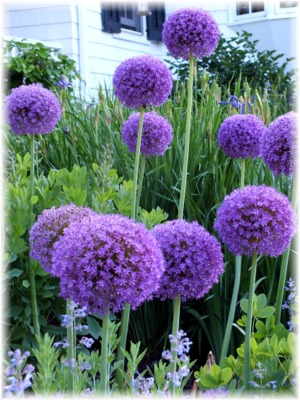Our love affair with Allium Globemaster continues unabated~there is nothing about it that we don't adore. It is the best tall globe-shaped Allium ever. It is healthy, strong and magnificently purple in luxurious shades of aster-violet that seems to change color in blazing sunshine or evening dusk (you can see the difference sunlight makes in these photos). Its colossal globes measure up to 10" around and are comprised of hundreds of little star-shaped florets that burst into bloom with delicate filament-like stamen. Exhilarated bees congregate gleefully around the gargantuan blooms, like pulsars orbiting purple suns. Globemaster makes your clients gardens really happy places, like birthday garden parties filled with purple balloons magically suspended 24" to 36" above the ground. Globemaster puts on one incredible show, giving the garden other-worldly natural architecture for weeks on end.
Like us on Facebook for flash alerts of website specials that include prized selections from among our 800+ collection of the world's best flower bulbs and Herbaceous Peonies at amazing wholesale prices. Your clients will adore our new Bee-Loved Two-Tone Allium Special as well as our classic Purple Planetoid, Buxom Purple Globe, Companion Heirloom and White Planetoid Allium Specials.
 Deer-and Rodent-Resistant Wonderus Beauty
Deer-and Rodent-Resistant Wonderus Beauty
A member of the Amaryllidaceae family, Allium are commonly called Flowering Onions and lucky for all of us, deer and rodents do not have a taste for onions. A 1971 Jan Bijl hybrid developed by crossing A. macleanii Baker and A. christophii (aka A. albopilosum), Allium Globemaster is one of the longest flowering Allium since its flowers are sterile~they don't produce seeds. Depending on spring temperatures, it can flower up to five weeks with ever enlarging floral globes that maintain their stage presence as they die back into dried spidery orbs. If it is happy where it is, Globemaster will return for many years with an ever-increasing stem count. One of our clients reported that her Globemasters were so happy in her garden that they multiplied from 24 to 60 flowering stems in just 3 years. This happens because little baby bulbs, called offsets or bulblets, grow on the sides of the mother bulb's basal plate. If flowers start to diminish in size, it may be time to gently dig them up in the fall and replant the bulblets away from the mother bulb to give them all room to grow and thrive. Allium Globemaster also makes one of the most jaw-dropping cut flowers. Its stunning flowers last an incredibly long time in over-the-top arrangements. They are also beautiful in combination with Herbaceous Peonies like Festiva maxima, Eden's Perfume or Riches and Fame.
 Easy Fall Planting
Easy Fall Planting
Hardy for horticultural zones 5 through 7, Allium Globemaster bulbs should be planted in the fall when the soil has cooled down to about 55°F (after two weeks of sweater weather when night time temps have hovered in the 40s). The plump 20 cm bulbs should be planted 6" to 8" deep and 8" to 10" apart with the pointed sprouting tip up, and the basal plate (bottom of the bulb where the roots grow) down.
Allium Globemaster needs a minimum of six hours of daily sunlight and well-draining, neutral pH soil: on the 1.0 to 14.0 pH scale, 7.0 is neutral. Lower than 7.0 is increasingly more acidic and higher than 7.0 is increasingly more basic or alkaline. Neutral pH soil allows bulbs to develop a mature root system that supports the development of the flower. Foliage only and no flower is a sign that there is an immature root system typically caused by acidic or alkaline soil pH.
Over time, Allium Globemaster benefits from a top dressing of a 4-10-6 or 5-10-5 granular, organic fertilizer top dressing (never within the planting hole because it could cause root burn) three times a year: at fall planting time, in the early spring when the sprouts emerge and when the flower starts to die back in late spring. If the winter threatens temperature spiking with inconsistent snow cover, Allium Globemaster would benefit from a 2 inch layer of mulch applied after the surface of the ground freezes. Good mulching mediums include straw, salt marsh hay or oak leaves. Prior to planting, Allium Globemaster bulbs may be stored in a cool, dry place with low humidity, away from heat, frost and strong sunlight at a temperature between 50°F and 70°F.
 Matches Made in Heaven
Matches Made in Heaven
Blooming after Narcissi and Tulips, Allium Globemaster are well-matched with Camassia, Dutch Iris, Eremurus and Herbaceous Peonies. They add heavenly color, joy and sparkle to the garden before Lilies, summer annuals and perennials burst into bloom. If your clients adore Allium Globemaster and want even more fabulous big globe-shaped purple blooms, you should consider Allium aflatunense Purple Sensation, christophii, Ambassador, Firmament, Gladiator, karataviense and Pinball Wizard. For contrast, consider the sparkling white varieties: Allium karataviense Ivory Queen, nigrum, stipitatum Mount Everest and stipitatum White Giant.




